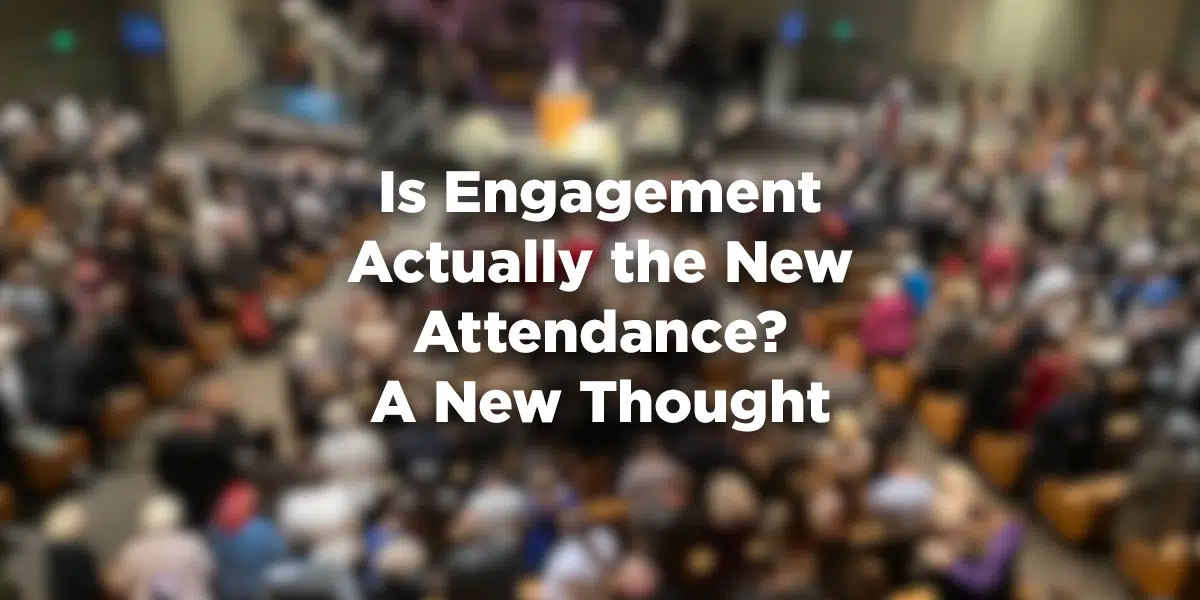YOU GOT THE POSITION... YOU'RE THE LEADER... NOW WHAT?
Menu

A quick FYI… We need more than one post to address this idea. This post sets up a significant problem facing our churches today. I’ll follow up with some solutions in future posts.
I’ve suggested this hundreds of times, and I’m not alone. Many church consultants, pastors, and Christian influencers have also suggested it.
It sure sounds good!
We may have been correct in 2015. And perhaps even in the early moments of the pandemic.
The “engagement matters more than attendance” mantra came from an accurate assessment of the church a decade ago. For too long, churches focused on filling seats over engaging people. That’s what consumer Christianity creates. People consume but don’t contribute.
Pastors, church leaders, and Christian influencers saw this reality and attempted to address the issue appropriately. The thought was, “If we emphasize participation, attendance will follow.” Moreover, “participation is part of a healthy discipleship pathway, so the more people engage, the more their faith will grow.”
Let’s address each of these assumptions before we consider some solutions.
Theoretically. It makes sense on the surface. If we can get people more involved, they’ll feel more connected and therefore be at church more frequently. You can’t serve at church if you’re not a church, right? Again, this makes sense.
Here’s the problem: People who attend once a month aren’t easily persuaded to commit to volunteer roles, group participation, inviting friends, or giving. In an odd twist, giving has become a first step of engagement in many churches. Don’t think generosity. Think tipping. It’s easier to give a dollar than an hour.
Let’s use volunteering at church to illustrate. If an average attendee is in a church service 1.3 times per month (a realistic average today), they give their church roughly 1.3 hours a month plus some travel time. When you ask this average person to volunteer, you’re asking them to go from 1.3 hours of church per month to potentially 3 or 4 hours, and that’s if they volunteer every other week and don’t attend a service. If you want them to volunteer one hour and attend another, you’re now asking them for 7 hours. If volunteering is weekly… well, you get the point. From 1.3 to 7 hours per month is a massive increase. No wonder people are so unlikely to sign up.
As people attended less, the thought was to focus on their engagement so attendance would be an outcome. Yet this didn’t work. People didn’t engage more, but they did attend less. And less.
I thought this, too. I promoted this publicly many times.
But here’s what I found, at least at the church I led: People engaging in our church weren’t necessarily growing in their faith.
Yes, some were. But many weren’t.
The more we focused on engagement, the more people we inspired (convinced) to engage, but these people weren’t automatically on a discipleship pathway just because they served as ushers or sat in a small group.
I hate to say it, but I know many people who were involved in our church for years and, in hindsight, would say their engagement did little for their faith. Engagement alone isn’t intentional.
When churches reconvened after the pandemic lockdowns, we saw a clear data point: Lots of people didn’t return to church. One reason became clear: They missed church for several months and didn’t really “miss” anything. Their lives didn’t get worse. Some told me their lives got better!
If you’re struggling to define a better discipleship pathway for today’s church, this may help.
The problem with our “engagement is the new attendance” mantra is it requires a level of attendance.
Think about it. “Engaging” requires some level of attendance. You can give and never show up, but serving, groups, inviting others, etc., requires physical presence.
Before you say “but online…” I understand, but digital ministry is a supplement, not a substitute, for spiritual growth. Digital channels alone are insufficient to create a robust and independent discipleship pathway.
If people don’t attend, they won’t engage. And if people don’t engage, we can’t create a more robust discipleship pathway for them beyond simple participation. For too long, we took attendance for granted. Now, we’re struggling to get people to a church experience, much less convince them to commit to a step.
Focusing on any one element of discipleship (like engagement) risks leaving out anything required before or after our focus. Great churches today understand that a full discipleship journey is the solution to growing faith. This includes creating a connection to the broader community, engaging in conversations and relationships with unchurched and de-churched people, integrating digital ministry components that build trust and offer support, creating a church service worth attending, leading people through an incrementally designed discipleship pathway, and resourcing people in your church to invest in others.
The days of simple engagement steps are over. It’s time to rethink church “engagement” from beginning to end. And that begins with rethinking attendance.
Stay tuned for a few more posts, and I’ll share some ideas and solutions that are working with the churches I’m working with.
